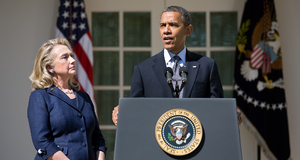The Obama PresidencyPredicting the Fate of the Judiciary After Obama
By
2015, Vol. 7 No. 02 | pg. 3/3 | « ConclusionNow the question remains as to whether or not judicial appointments will join the list of Obama’s successes or failures. For the time being, the Obama Administration has been able to highlight their diverse judicial appointees as a significant success of the Obama Presidency. The administration overcame the obstacles presented by the Republican Party and was able to appoint many women, ethnic minorities, and members of the gay community to the judiciary. These appointees have been relatively young and will continue to serve on the federal benches long after Obama leaves office, remaining a successful part of his legacy. As mentioned, there is the possibility that Obama will have the opportunity to appoint another Supreme Court Justice. Given the hyperpolarization and the new Republican Senate, I think that there is a real possibility that the Senate could cause such delays and obstruction that President Obama is unable to successfully make a nomination. This would become a major part of his legacy, and be a clear failure of his administration. A second option would be that he is able to successfully appoint a new Supreme Court Justice. However I think that this too could be construed as a failure, as President Obama would have to engage in significant compromise with the Senate Republicans and would ultimately be appointing a Justice more conservative and traditional than most Democrats would like to see.A failure associated with the appointment of a Supreme Court Justice would be the ultimate failure regarding the judiciary, and would likely overshadow President Obama’s successes in appointing a diverse selection of judges to the lower courts. The media, and subsequently the public pay more attention to Supreme Court nominations than nominations to the lower courts, contributing to this effect. In conclusion, it is far too early to make a judgment on the success or failure of the Obama Administration in regards to judicial nominations. With two years remaining in office for Obama, there are too many possibilities for change. While the predictions may help analyze an outcome, they remain predictions and rely on many “ifs.” Whether as a success or as a failure, it is very evident that the judiciary will become an important part of President Obama’s legacy. ReferencesAdam Liptak. “Justice Ginsburg is Recovering After Heart Surgery to Place Stent.” The New York Times. 26 November 2014. Al Kamen. “In the Loop: Obama Judges Tip Appeals Court to Democrats.” The Washington Post. 29 May 2014. Benjamin Wittes. “Transformation of Judicial Confirmations.” Confirmation Wars: Preserving Independent Courts in Angry Times. (Maryland: Rowman & Little Field, 2006). Pages 37-84. Ezra Klein. “Nine Reasons the Filibuster Change is a Huge Deal.” The Washington Post. 21 November 2013. Jeffrey Toobin. “The Obama Brief: The President Considers His Judicial Legacy.” The New Yorker. 27 October 2014. Jessica Weisberg. “Supreme Court Justice Ruth Bader Ginsburg: I’m Not Going Anywhere.” Elle Magazine. 23 September 2014. Lindsay Holst. “Here’s Why Today’s Filibuster Rule Change is a Big Deal.” WhiteHouse.gov. 21 November 2013. Matt Bai. “What Obama’s Loss of Congress Means for 2016 Candidates.” Yahoo News. 5 November 2014. Neil A. Lewis. “Obama’s Court Nominees Are Focus of Speculation.” The New York Times. 10 March 2009. Pew Research Center. “As Midterms Near, GOP Leads on Key Issues, Democrats Have a More Positive Image.” 23 October 2014. Randall Kennedy. “The Case for Early Retirement.” New Republic. 28 April 2011. Russell Wheeler. “Judicial Nominations and Confirmations: Fact and Fiction.” The Brookings Institute. 30 December 2013. Russell Wheeler. “Speculating About Obama’s Judicial Confirmations in the Next Congress.” The Brookings Institute. 19 September 2014. Sheldon Goldman, Elliot Slotnick, and Sara Schiavoni. “Obama’s Judicial Appointments in a Time of Extraordinary Obstruction.” Scholars Strategy Network. August 2013. Pages 1-2. Supreme Court of the United States. “Members of the Supreme Court of the United States.” SupremeCourt.gov. 29 November 2014. Thomas B. Edsall. “Election 2014: What Do the Midterms Tell Us About 2016?” The New York Times. 4 November 2014. United States Census Bureau. “Age and Sex Composition.” 2010 Census Brief. May 2011. The White House. “Infographic: President Obama’s Judicial Nominees.” WhiteHouse.gov 24 September 2013. Endnotes1.) In accordance with Sheldon Goldman’s works, delay will refer to an instance where it took more than 180 days from the date of nomination to the date of confirmation and obstruct will mean that no action was taken either to confirm or deny a nominee. 2.) Sheldon Goldman, Elliot Slotnick, and Sara Schiavoni. “Obama’s Judicial Appointments in a Time of Extraordinary Obstruction.” Scholars Strategy Network. August 2013. Page 1. 3.) “Infographic: President Obama’s Judicial Nominees.” WhiteHouse.gov. 24 September 2013. 4.) Goldman, Slotnick & Schiavoni. “Time of Extraordinary Obstruction.” Page 1. 5.) “Infographic: Judicial Nominees.” 6.) Russell Wheeler. “Judicial Nominations and Confirmations: Fact and Fiction.” The Brookings Institute. 30 December 2013. 7.) Goldman, Slotnick & Schiavoni. “Time of Extraordinary Obstruction.” Page 1. 8.) “Infographic: Judicial Nominees.” 9.) Wheeler. “Judicial Nominations and Confirmations.” 10.) “Infographic: Judicial Nominees.” 11.) Goldman, Slotnick & Schiavoni. “Time of Extraordinary Obstruction.” Page 1 -2. 12.) Ezra Klein. “Nine Reasons the Filibuster Change is a Huge Deal.” The Washington Post. 21 November 2013. 13.) Lindsay Holst. “Here’s Why Today’s Filibuster Rule Change is a Big Deal.” WhiteHouse.gov. 21 November 2013. 14.) Goldman, Slotnick & Schiavoni. “Time of Extraordinary Obstruction.” Page 1. 15.) Jeffrey Toobin. “The Obama Brief: The President Considers His Judicial Legacy.” The New Yorker. 27 October 2014. 16.) A “traditional” nominee will be defined as a straight, white male. Subsequently a “non-traditional” nominee will refer to women, members of ethnic minorities, those that are openly gay, or any combination of these characteristics. This is in keeping with Sheldon Goldman’s works. 17.) Toobin. “The Obama Brief.” 18.) “Infographic: Judicial Nominees.” 19.) “Infographic: Judicial Nominees.” 20.) United States Census Bureau. “Age and Sex Composition.” 2010 Census Brief. May 2011. 21.) Supreme Court of the United States. “Members of the Supreme Court of the United States.” SupremeCourt.gov. 29 November 2014. 22.) “Infographic: Judicial Nominees.” 23.) “Infographic: Judicial Nominees.” 24.) Al Kamen. “In the Loop: Obama Judges Tip Appeals Court to Democrats.” The Washington Post. 29 May 2014. 25.) Kamen. “In the Loop.” 26.) Neil A. Lewis. “Obama’s Court Nominees Are Focus of Speculation.” The New York Times. 10 March 2009. 27.) Kamen. “In the Loop.” 28.) Toobin. “The Obama Brief.” 29.) Russell Wheeler. “Speculating About Obama’s Judicial Confirmations in the Next Congress.” The Brookings Institute. 19 September 2014. 30.) Wheeler. “Speculating About the Next Congress.” 31.) Matt Bai. “What Obama’s Loss of Congress Means for 2016 Candidates.” Yahoo News. 5 November 2014. 32.) Pew Research Center. “As Midterms Near, GOP Leads on Key Issues, Democrats Have a More Positive Image.” 23 October 2014. 33.) Thomas B. Edsall. “Election 2014: What Do the Midterms Tell Us About 2016?” The New York Times. 4 November 2014. 34.) Holst. “Filibuster Rule Change is a Big Deal.” 35.) Klein. “Filibuster Change is a Huge Deal” 36.) Wheeler. “Fact and Fiction.” 37.) The term blue refers to a preference for candidates from the Democratic Party. Red would alternately refer to a preference for the Republican Party. 38.) Edsall. “Election 2014.” 39.) Jessica Weisberg. “Supreme Court Justice Ruth Bader Ginsburg: I’m Not Going Anywhere.” Elle Magazine. 23 September 2014. 40.) Adam Liptak. “Justice Ginsburg is Recovering After Heart Surgery to Place Stent.” The New York Times. 26 November 2014. 41.) Weisberg. “I’m Not Going Anywhere.” 42.) Toobin. “The Obama Brief.” 43.) Randall Kennedy. “The Case for Early Retirement.” New Republic. 28 April 2011. 44.) Kennedy. “The Case for Early Retirement.” 45.) Goldman, Slotnick & Schiavoni. “Time of Extraordinary Obstruction.” Page 2. 46.) Ibid. 47.) Toobin. “The Obama Brief.” 48.) Toobin. “The Obama Brief.” 49.) Benjamin Wittes. “Transformation of Judicial Confirmations.” Confirmation Wars: Preserving Independent Courts in Angry Times. (Maryland: Rowman & Little Field, 2006). Pages 37-84. Suggested Reading from Inquiries Journal
Inquiries Journal provides undergraduate and graduate students around the world a platform for the wide dissemination of academic work over a range of core disciplines. Representing the work of students from hundreds of institutions around the globe, Inquiries Journal's large database of academic articles is completely free. Learn more | Blog | Submit Latest in Political Science |
















